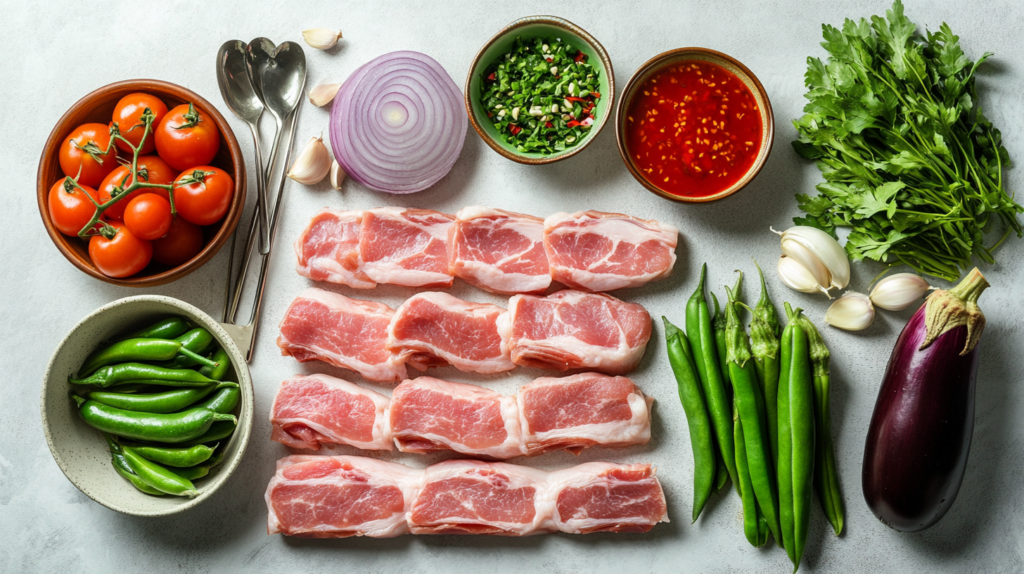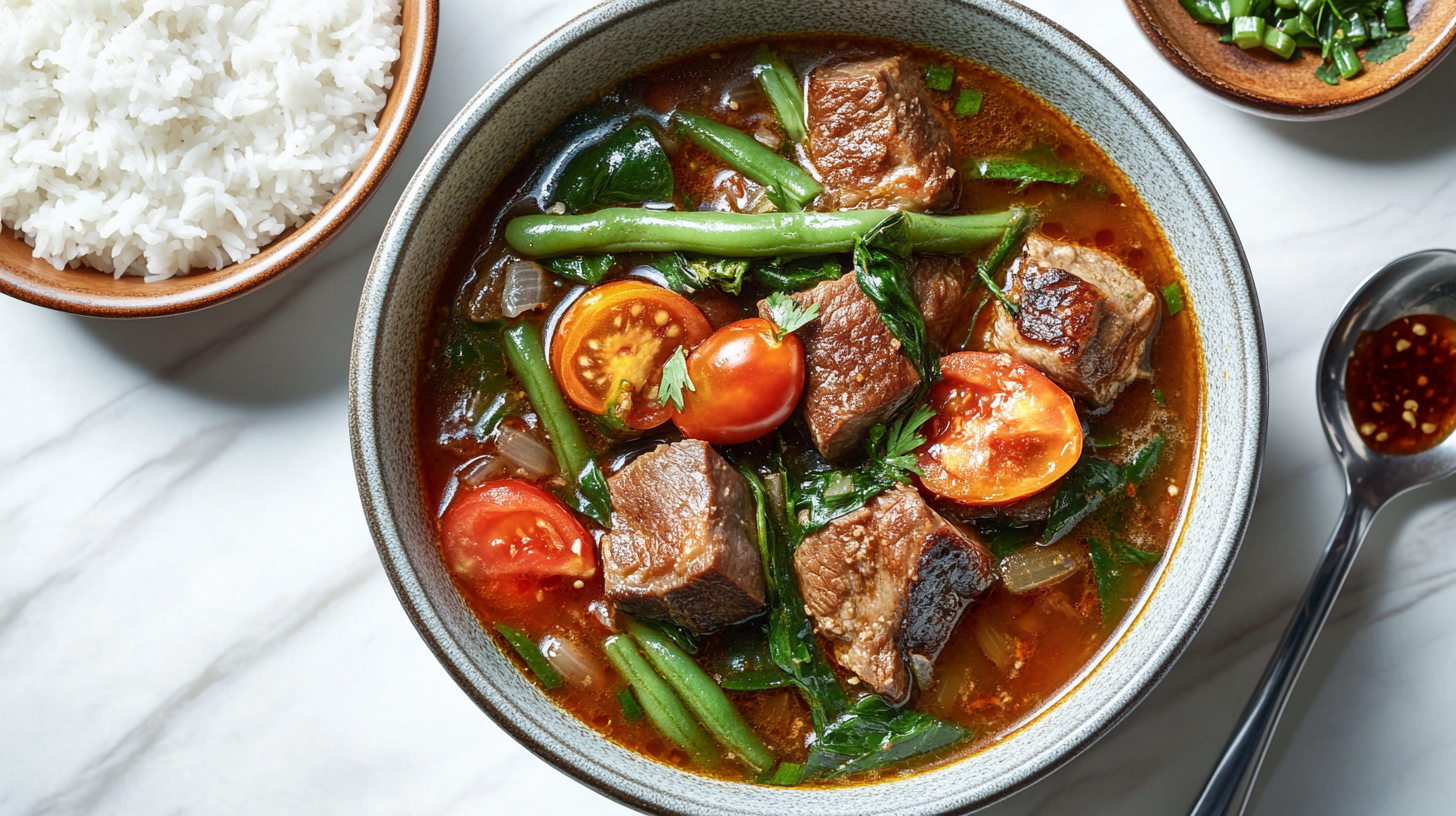Sinigang is more than just a dish; it’s an experience. With its tangy, savory broth and vibrant mix of ingredients, this Filipino staple is a favorite comfort food for many. Whether you’re new to Filipino cuisine or a seasoned cook looking to perfect your sinigang recipe, this guide is here to help you create a pot of pure magic.
Introduction to Sinigang
What is Sinigang?
Sinigang is a traditional Filipino soup known for its distinctive sour flavor. It’s typically made with a tamarind-based broth and filled with vegetables and a protein of your choice. The sourness of sinigang is its defining trait, offering a unique contrast to the savory elements that make each spoonful unforgettable.
Imagine a rainy day where every sip feels like a warm hug — that’s sinigang recipe magic for you! 🍲
Table of contents
- Introduction to Sinigang
- Key Ingredients for an Authentic Sinigang Recipe- Mastering the Basics of Filipino Sinigang
- Variations of Sinigang – Exploring the Best Sinigang Recipe Options
- Pork Sinigang (Sinigang na Baboy) – The Most Popular Filipino Sinigang Recipe
- Shrimp Sinigang (Sinigang na Hipon) – A Seafood Twist to Classic Sinigang
- Fish Sinigang (Sinigang na Isda) – A Healthy Filipino Sinigang Alternative
- Beef Sinigang (Sinigang na Baka) – A Hearty Sinigang Recipe for Meat Lovers
- Vegetarian Sinigang – A Plant-Based Take on Sinigang Soup
- Step-by-Step Guide to Cooking Sinigang – Perfect Your Filipino Sinigang Recipe
- Common Problems and Solutions in Cooking Sinigang
- Serving Sinigang – Presenting Your Filipino Sinigang Recipe
- Frequently Asked Questions About Sinigang
- Discover More Flavorful & Comforting Recipes
- Conclusion: Perfecting Your Sinigang
The History and Cultural Significance of Sinigang
Sinigang recipe has been a part of Filipino households for centuries. Its origins are deeply rooted in the Philippines’ agricultural tradition, where fresh, local ingredients are celebrated. Families gather around the dining table to enjoy this hearty dish, often sharing stories and laughter with every bowl served. It’s more than food; it’s a cultural icon that connects generations.
“Sinigang recipe is not just about eating; it’s about savoring memories and creating new ones.”
Key Ingredients for an Authentic Sinigang Recipe- Mastering the Basics of Filipino Sinigang
Tamarind and Other Souring Agents – The Heart of Every Sinigang Recipe
The soul of sinigang lies in its sour broth. Tamarind is the traditional souring agent, but there are alternatives like calamansi, kamias (bilimbi), or even green mangoes. Each option gives the dish a slightly different flavor profile. Tamarind offers a classic tang, while calamansi gives a citrusy brightness. Feel free to experiment to find your favorite!
A lesser-known option is miso, which adds a savory, umami depth to the broth while complementing the sourness. This variation, called Sinigang sa Miso, is particularly popular in regions where fish sinigang is common.
Choosing the Right Protein: Pork, Shrimp, Fish, and More (H3) – Building the Perfect Sinigang Base
What’s your protein of choice? Pork belly (liempo) is a popular option because of its tender, juicy texture. Shrimp and fish are lighter alternatives that still pack plenty of flavor. Beef short ribs or oxtail make for a rich and hearty version, while tofu is perfect for vegetarians. The key is to choose a protein that complements the tangy broth.
For seafood sinigang, many opt for bangus (milkfish) or prawns. The natural sweetness of seafood perfectly balances the sour broth, making it a refreshing yet hearty choice. For those looking to mix proteins, combining pork and shrimp is also a winning combination.
Essential Vegetables for Sinigang (H3) – Adding Flavor and Texture to Your Sinigang Soup
Vegetables add texture, color, and nutrients to sinigang. The usual suspects include kangkong (water spinach), sitaw (string beans), labanos (radish), and eggplant. Some also add gabi (taro) for a thicker, creamier broth. Don’t forget the tomatoes and onions — they’re the foundation of the broth’s rich flavor.
For a unique twist, some cooks include okra, which softens beautifully in the broth, or bell peppers for a hint of sweetness. Seasonal vegetables like pechay (bok choy) or even corn can elevate the dish, adding a subtle crunch and sweetness to the tangy base.
Variations of Sinigang – Exploring the Best Sinigang Recipe Options
Pork Sinigang (Sinigang na Baboy) – The Most Popular Filipino Sinigang Recipe
Pork sinigang is the most popular version. The richness of the pork belly or ribs balances beautifully with the sour broth. It’s a comfort classic that’s hard to beat. To enhance the dish, some add crispy fried pork skin (chicharrón) as a topping for an added crunch.
Shrimp Sinigang (Sinigang na Hipon) – A Seafood Twist to Classic Sinigang
Shrimp sinigang is a lighter option that’s perfect for seafood lovers. The sweetness of the shrimp enhances the tangy broth, making it a refreshing choice for any meal. When preparing shrimp sinigang, leave the shells on during cooking for a more robust, flavorful broth.
Fish Sinigang (Sinigang na Isda) – A Healthy Filipino Sinigang Alternative
Fish sinigang, often made with bangus (milkfish), is a healthier alternative that’s equally flavorful. Its clean, light taste pairs wonderfully with the sour and savory elements of the dish. For an added layer of complexity, fish sinigang can be made into Sinigang sa Miso by incorporating miso paste into the broth.
Beef Sinigang (Sinigang na Baka) – A Hearty Sinigang Recipe for Meat Lovers
For a heartier version, beef short ribs or oxtail are excellent choices. The slow-cooked meat becomes incredibly tender, and its natural richness deepens the flavor of the broth. Adding bone marrow to beef sinigang elevates the dish, creating a luxurious texture and flavor that pairs perfectly with the sour base.
Vegetarian Sinigang – A Plant-Based Take on Sinigang Soup
Vegetarian sinigang is a delightful option for plant-based eaters. Substitute tofu for the protein and add a variety of vegetables for a wholesome, nutrient-packed meal. Mushrooms, especially shiitake or oyster, can add an umami punch to the broth, making it just as satisfying as the meat-based versions.
Step-by-Step Guide to Cooking Sinigang – Perfect Your Filipino Sinigang Recipe
Preparing the Ingredients – Getting Ready for Your Sinigang Dish
Before you start, make sure all your ingredients are fresh and ready. Wash your vegetables thoroughly, cut your protein into manageable pieces, and prepare your souring agent. A well-prepped kitchen sets you up for sinigang success!
For tamarind, you can use fresh pods, tamarind paste, or sinigang mix. If using fresh pods, boil them in water and mash to extract the juice before adding it to your pot.
Cooking Techniques for Perfect Sinigang – Filipino Sinigang Made Easy
Start by sautéing onions and tomatoes until soft. Add your protein and cook until lightly browned. Pour in water and let it simmer. Add your souring agent and vegetables, starting with the harder ones like radish and taro. Adjust the seasoning with fish sauce and let the flavors meld together.
To elevate the broth, consider roasting the tomatoes and onions before adding them to the pot. This step caramelizes their natural sugars, adding a subtle depth to the soup’s flavor.
“The secret to a great sinigang recipe? Patience and a lot of love stirred into the pot.” 🍲
Tips for Adjusting the Sourness and Flavor
Sinigang is all about balance. If it’s too sour, a splash of fish sauce or a pinch of sugar can mellow it out. If it’s not sour enough, add more tamarind or calamansi juice. Taste as you go and trust your palate.
For a richer broth, some cooks add a tablespoon of fish sauce during the sautéing process. This helps layer the savory flavors early on.
Common Problems and Solutions in Cooking Sinigang
Why Does My Sinigang Taste Bland?
Bland sinigang is a common issue, but it’s easy to fix! Often, the problem lies in under-seasoning. Don’t shy away from using fish sauce or salt to bring out the flavors. If the broth still lacks depth, try simmering it longer to let the ingredients release their natural flavors.
How to Balance Sourness and Saltiness
Striking the right balance between sour and salty is the key to an unforgettable sinigang recipe. If your soup is too salty, a little more water or a few extra vegetables can help dilute it. Conversely, if it’s too sour, a splash of coconut milk can soften the sharpness without compromising the dish’s character.
Avoiding Overcooked Vegetables
Overcooked vegetables can make your sinigang less appealing. To prevent this, add the vegetables in stages based on their cooking times. Start with sturdier ones like taro and radish, and save delicate greens like kangkong for the final few minutes.
For added texture, serve the sinigang with lightly blanched vegetables on the side, allowing diners to add them directly to their bowls.
Serving Sinigang – Presenting Your Filipino Sinigang Recipe
Best Side Dishes to Pair with Sinigang
Sinigang is a versatile dish that pairs wonderfully with a variety of side dishes. Steamed white rice is a classic choice, soaking up the tangy broth with every bite. Crispy fried

How to Store and Reheat Leftover Sinigang
Leftover sinigang? Lucky you! Store it in an airtight container and keep it in the fridge for up to three days. To reheat, simply bring it to a gentle simmer on the stove. If the broth has thickened, add a splash of water to restore its original consistency. Pro tip: leftover sinigang tastes even better the next day as the flavors deepen overnight.
For freezing, separate the broth and the vegetables to prevent the latter from becoming too mushy. Reassemble them when reheating for a freshly cooked feel.
Frequently Asked Questions About Sinigang
Can I Use Instant Sinigang Mix?
Absolutely! Instant sinigang mix is a convenient option for those short on time. While it may not offer the same depth of flavor as fresh tamarind, it still delivers a deliciously tangy broth. Feel free to enhance it with fresh tomatoes, onions, and additional vegetables to make it your own.
For a more authentic taste, combine instant mix with a small amount of fresh tamarind or calamansi juice to add complexity to the broth.
What’s the Best Way to Customize Sinigang?
Sinigang is incredibly versatile, so don’t be afraid to get creative! Add your favorite vegetables, experiment with different proteins, or adjust the sourness to suit your taste. Want a richer broth? Try adding a spoonful of miso paste for a unique twist. The beauty of sinigang lies in its adaptability, allowing you to make it uniquely yours.
For an elevated presentation, garnish your sinigang with freshly chopped cilantro or green onions before serving. It adds color and a burst of freshness to the dish.
For fans of hearty and comforting dishes, our Sinigang Recipe is a must-try. To complement the bold and tangy flavors of sinigang, consider pairing it with a warm and crispy side like our Southern Cornbread Recipe. If you’re looking for more creative dishes, try the luxurious Crab Brûlée Recipe for a touch of indulgence. For dessert, finish your meal with the sweet and satisfying Pumpkin Banana Loaf, offering the perfect balance to your savory dish.
Discover More Flavorful & Comforting Recipes
If you enjoyed this tangy, savory Sinigang Recipe, you’ll love exploring more soul-warming meals and globally inspired comfort foods. Whether you want more stews, sides, or traditional favorites, here’s what to try next:
- Warm up with another rich bowl like the Brisket Chili Recipe – A Hearty and Flavorful Comfort Food
- Looking for a zesty seafood twist? Don’t miss the BBQ Shrimp Recipe – A Bold and Juicy Southern Favorite
- Add a classic Filipino-inspired side with this vibrant Purple Sweet Potato Recipe – Delicious and Nutritious
- Prefer something meaty and tender? Try the Boneless Beef Ribs Recipe – A Perfectly Tender and Flavorful Dish
- For a complete family-style dinner, explore this Chicken and Yellow Rice Recipe – A Flavorful and Easy Meal
- Enjoy more tropical flavors with this Mango Fruit Dessert Recipes – Sweet and Refreshing Treats for Every Occasion
- Need a refreshing pairing? Try the Pomegranate Juice Recipe – A Refreshing, Healthy Homemade Drink
- Looking for more comfort food classics? Don’t miss the Meatloaf Recipe (Lipton Onion Soup) – The Ultimate Comfort Food
- Turn your leftover proteins into something new with these Leftover Rotisserie Chicken Recipes – Delicious and Easy Meal Ideas
- Keep it cozy with this side: Campbell’s Green Bean Casserole Recipe – A Classic and Comforting Side Dish
Please check out other recipes on the site to continue discovering flavorful, heartwarming dishes from all over the world.
Conclusion: Perfecting Your Sinigang
Mastering the art of cooking sinigang is a rewarding journey. With its rich history, vibrant flavors, and endless possibilities, this dish has rightfully earned its place as a Filipino favorite. Whether you’re making pork, shrimp, or vegetarian sinigang, the key is to balance the sour and savory elements to create a bowl of comforting goodness.
Sinigang is more than just a recipe; it’s a celebration of Filipino heritage and a testament to the country’s love for bold, hearty flavors. It’s a dish that brings families together, sparks conversations, and warms the soul.
So, gather your ingredients, grab your ladle, and dive into the world of sinigang. Whether it’s for a family dinner or a solo treat, this dish never fails to bring warmth and joy to the table. As the steam rises and the flavors meld together, you’ll understand why sinigang is not just a recipe — it’s a tradition, a memory, and a celebration of Filipino cuisine. 🍲✨

